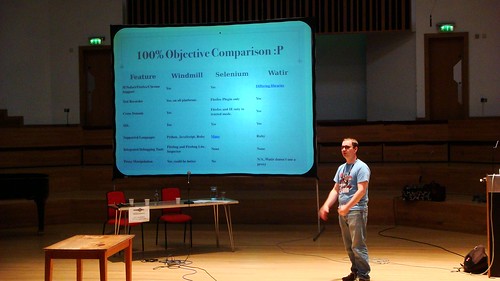This talk was held by Mikeal Rogers from the Mozilla Foundation and all about web testing with the Windmill project.
Problem in general with web testing is that you cannot unittest it, it’s always a functional test. In web testing you even more blur the line between functional and unit testing. You need broader coverage in real world non-ideal scenarios. You probably won’t do it with a test fixture then but simply use your live site.
What are the tools for web application testing?
Broadly two categories:
Browserless Tools
- Raw HTTP tools
- Browser Simulation Tools
- JavaScript interpreters (but problem is e.g. that a DOM implementation is on spec and does not look like a browser)
Browser Tools
- Selenium
- Windmill (own rewrite because of problems with Selenium)
- Watir (takes a different approach: implements a trusted module in IE/Firefox etc.)
Tools are not really comparable. He showed nevertheless some example comparison:
- Windmill and Selenium supports all major browsers with one product, Watir needs different libraries
- Test recorder works on every browser for Windmill and Watir, with Selenium only with trusted FF plugin
- All three work cross domain and support SSL
- Windmill supports Python, JavaScript, Ruby. Selenium many, Watir just Ruby.
- Integrated Debugging Tools: Firebug, FB Lite and Inspector for Windmill. Selenium has no tools, as well as Watir
- Proxy Manipulation: There in Windmill but could be better, not there in Selenium, Watir does not use a proxy. What that means is that you can control what will come through the proxy and manipulate requests etc.
He then showed small screencasted videos demonstrating writing tests and debugging tests.
Technorati-Tags: europython, europython2009, windmill, testing, conference
